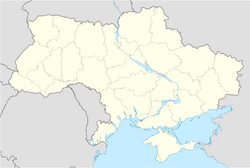| Main | Births etc |
|---|
| Khust Хуст |
|||
|---|---|---|---|
| — Town — | |||
| City Hall of Khust | |||
|
|||
| Coordinates: Coordinates: | |||
| Country Oblast Raion |
Khust Rayon |
||
| Founded | 1090 | ||
| Incorporated | 1329 | ||
| Subordinated villages | List
Chertizh (Чертіж)
Kireshi (Кіреші} Zarichne (Зарічне} |
||
| Government | |||
| • Mayor | Mykhailo Djanda | ||
| Elevation | 164 m (538 ft) | ||
| Population (2010) | |||
| • Town | 31,083 | ||
| • Density | 1,298.140/km2 (3,362.17/sq mi) | ||
| • Metro | 31,864 | ||
| Time zone | CET (UTC+1) | ||
| • Summer (DST) | CEST (UTC+2) | ||
| Postal code | 90400 | ||
| Area code(s) | +380-3142 | ||
| Website | Khust City Portal | ||
Khust (Ukrainian, Russian, and Rusyn: Хуст, Romanian: Hust, Hungarian: Huszt, Czech and Slovak: Chust, Yiddish: חוסט) is a city located on the Khustets River in the Zakarpatia oblast (province) in western Ukraine. It is near the confluence of the Tisza and Rika Rivers. Serving as the administrative center of the Khust Rayon (district), the city itself is also designated as a separate rayon within the oblast, and is located at around . The villages of Chertizh (Чертіж), Kireshi (Кіреші} and Zarichne (Зарічне} are administratively subordinated to the city.
Khust was the capital of the short-lived republic of Carpatho-Ukraine.
Origin of name[]
The name is possibly related to the name of the stream Husztica. It is also conceivable that the name of the city comes from a Romanian traditional food ingredient - husti.
History[]
The settlement was first mentioned as Huszth, in 1329. Its castle was built in 1090 by St. Ladislaus as a defence against the Cumans, was destroyed during the Mongol invasion of Hungary and was rebuilt around 1318. The town got privileges in 1329.
In 1458 King Matthias imprisoned his uncle, the rebellious Mihály Szilágyi in the castle. In 1514, during György Dózsa's peasant revolt local peasants captured the castle. In 1526 the area became a part of Transylvania.
The army of Ferdinand I captured the town in 1546. In 1594 the Tartars destroyed the town, but could not take the castle. The castle was besieged in 1644 by the army of George I Rákóczi, in 1657 by the Polish, in 1661-62 by the Ottoman and Tartar hordes. Count Ferenc Rhédey, the ruling prince of Transylvania and high steward of Máramaros county died in the castle on May 13, 1667.
The castle surrendered to the Kurucs on August 17, 1703, and the independence of Transylvania was proclaimed here. It was the last castle the Habsburgs occupied when suppressing the freedom fight of the Kurucs, in 1711. The seriously damaged castle was struck by lightning and burnt down on July 3, 1766; a storm brought down its tower in 1798, it has been in ruins ever since then. Huszt was renamed as Csebreny in 1882 during Magyarization process.
In 1910 Huszt had 10,292 citizens, 5,230 Ruthenians, 3,505 Hungarians and 1,535 Germans. Until the Treaty of Trianon it belonged to Hungary and was the seat of the Huszt district of Máramaros county. After World War I, in summer 1919 the Rumanian troops took over the territory. But according to the St.-Germain treaty Czechoslovakia received the city, as part of newly formed Podkarpatsko(Under the Carpathians) region. Czechoslovakia had to provide the region a wide autonomy, but it was realised only in 1938. In autumn 1938 an autonomous government was organised. On the other day after the collapse of Czechoslovakia on March 14, 1939, the government proclaimed an independence in Khust, that was not recognised by the leading states. One day later, on March 16, 1939 the Hungarian troops moved in. On October 24, 1944 the soviet troops occupied the city, and included it into the Soviet Union. The Soviet government exiled most of the city's German and Hungarian population. Since the collapse of USSR, Khust is part of Ukraine.
Demographics[]
In 2001 it had 31,900 inhabitants, including: [1]
- 28,500 (89.3%) Ukrainians
- 1,700 (5.4%) Hungarians
- 1,200 (3.7%) Russians
- 100 (0.4%) Gypsies
Until the 19th century the city's population also included ethnic Romanians (800 Romanians according to the 1880 census).
Tourist sights[]
- Castle ruins
- Protestant fortress church 13th-14th century, Protestant since 1524, fortified in 1616, 1644, 1661 and 1670, restored in 1773 and 1888. Its belfry is from the 15th century, until 1861 it had four pinnacles.
- Roman Catholic church (Baroque, 18th century)
- Greek Orthodox church (18th century)
Famous people[]
- Jenő Benda, writer, journalist was born here in 1882.
- Leslie Buck (born Laszlo Büch), American business executive and Holocaust survivor, designer of the Anthora coffee cup, was born in Khust in 1922.[1][2]
- József Koller, historian of religion was born here in 1745.
- Ernő Szép writer was born here in 1894.
- Count József Teleki scientist was born here on December 21, 1738.
- Veronica Vovchuk (* 1990), Queen of the World, an international top model and actress with their own cosmetics line, "Queen Veronica"
See also[]
References[]
- ^ Fox, Margalit (2010-04-29). "Leslie Buck, Designer of Iconic Coffee Cup, Dies at 87". New York Times. http://www.nytimes.com/2010/04/30/nyregion/30buck.html. Retrieved 2010-05-31.
- ^ "NY coffee cup creator Leslie Buck dies at 87". The Daily Telegraph. 2010-05-01. http://www.telegraph.co.uk/news/worldnews/northamerica/usa/7661183/NY-coffee-cup-creator-Leslie-Buck-dies-at-87.html. Retrieved 2010-06-05.
External links[]
- Khust in the Encyclopedia of Ukraine
- All about Khust City Includes a large image of the city and castle.
- Khust City elections in 2003
- Place names of Maramaros County
| ||||||||||||||||



